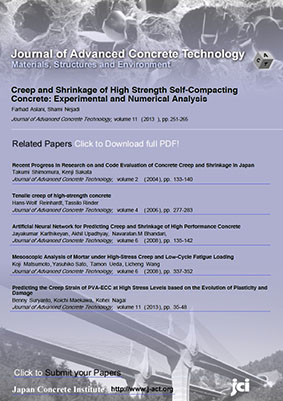巻号一覧

12 巻, 5 号
選択された号の論文の3件中1~3を表示しています
- |<
- <
- 1
- >
- >|
科学論文
-
Susumu Takahashi, Sefatullah Halim, Toshikatsu Ichinose, Go Kotani, M ...2014 年 12 巻 5 号 p. 138-145
発行日: 2014/05/09
公開日: 2014/05/09
ジャーナル フリーThis study describes the strength of reinforced concrete (RC) beam-column joints in buildings with a soft first story. In such buildings, the sections of first-story columns are usually much larger than those of second-story columns to prevent story collapse. To investigate the strength of the beam-column joints, four specimens are constructed and the test is conducted with two types of joints: 1) the first-story column is extended toward the inside of the building (I-type joint) and 2) the first-story column is extended toward the outside of the building (O-type joint). The test parameters are the hoops in the beam-column joint, beam reinforcements, stirrups in the beam, and axial force. The beam longitudinal re-inforcements are effective to prevent the yielding of the beam reinforcements in both types of joint. Stirrups in beam and hoops in joint strengthen I- and O-type joints, respectively. The force-resistant mechanisms of these joints are different from those of usual beam-column joints because sign of the bending moment in the second-story column is the same as that of the first-story column. The failure modes of these joints are also different from those of the usual beam-column joints.抄録全体を表示PDF形式でダウンロード (920K) -
Sefatullah Halim, Susumu Takahashi, Toshikatsu Ichinose, Masaomi Teshi ...2014 年 12 巻 5 号 p. 146-157
発行日: 2014/05/09
公開日: 2014/05/09
ジャーナル フリーPart-1 of this study presents the experimental results of beam-column joints in soft-first story buildings, in which the first-story column depth is twice that of the upper stories. In Part-2, strut-and-tie models (STMs) are developed for the specimens. The flow of internal forces shown by the developed strut-and-tie models agreed with the observed cracks. The developed models for the joints are different from those for the usual joint: the main difference is that, in the specimens large struts were extended into the wall panel. STMs are also developed for the total frame to understand the overall equilibrium. Based on the STMs, new design equations are proposed, where the joint strength is evaluated as the sum of the flexural strengths of the beam and the second-story column. In I-type joint, the effect of the wall panel and beam stirrups is also considered. In O-type joint, the effect of the hoops in the joint is also considered.抄録全体を表示PDF形式でダウンロード (1599K) -
Yingdi Liao, Da Chen, Zihan Liu, Feng Ouyang, Lijun Hou2014 年 12 巻 5 号 p. 158-166
発行日: 2014/05/28
公開日: 2014/05/28
ジャーナル フリーIn this paper, a multi-axial compression constitutive model of cement-based material subjected to combined alkali-silica reaction (ASR) and mechanical loading is proposed based on the plastic and damage theories. In this model, the elastoplastic behavior is coupled with the mechanical damage due to external loading and chemical damage due to ASR ex-pansion. The linear swelling rate of prism specimen is used to represent the ASR damage. A modified plastic yielding criterion and plastic potential function are introduced, taking into account the ASR damage on compression and tension properties. The proposed model is further verified by the tested stress-strain relationship under different confining pressures reported in a companion paper, and a good agreement is obtained.抄録全体を表示PDF形式でダウンロード (596K)
- |<
- <
- 1
- >
- >|